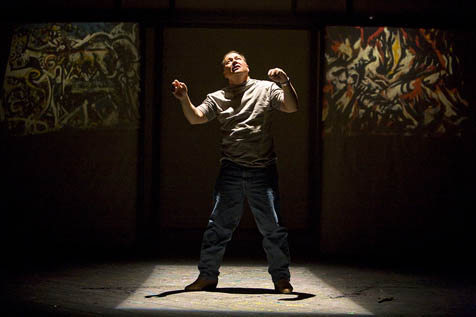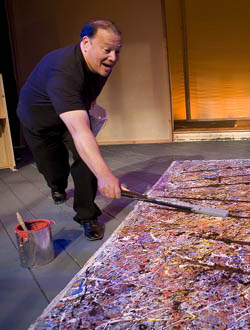Fifteen Rounds with Jackson Pollock. At Victoria Hall Theater, Thursday, May 31. Shows through June 16.
Knockout Drama

Jackson Pollock has interested dramatists for decades, mostly for the wrong reasons. Stylish, self-destructive, and immature, the painter’s public persona has the outsized, cartoonish presence of an archetype-the artist as cultural prizefighter. At first glance, Bruce Clark’s Fifteen Rounds with Jackson Pollock, with its title reference to the boxing ring, appears to have bought into this distinctly grandiose version of Pollock’s life and art, but seeing it at Victoria Hall last week, it became obvious within the first few “rounds” that this was not the case. The play takes a thoughtful and refreshing look at the painter’s later career, delving into the relationships and concerns that drove his major artistic decisions. While it may not have the familiar dramatic structure of a traditional play, this Pollock delivers plenty of theatrical excitement and insight.

Ed Giron inhabits Pollock, insecurities and all, with a bold assurance that carries through all 15 rounds. From the moment we first spy him stalking the big, floor-bound canvases in his Springs studio, pouring sticks in hand, Giron makes us believe in the man’s creative impulse and capacity to make art. As the influential critic Clement Greenberg, Jerry Oshinsky manages just the right mixture of unctuousness and genuine intelligence. In his scenes with Pollock at the Betty Parsons Gallery, Greenberg pulls off the remarkable trick of at once laying out the artist’s formidable strengths and playing on his weaknesses. Jennifer Gimblin does a great job with the difficult role of Lee Krasner, who must exhibit her own art in the relentless glare of her husband’s greater fame, all the while keeping watch over his increasing dependence on alcohol. Sean O’Shea takes a remarkable turn as Hans Namuth, the young photographer who cajoles Pollock into posing for the now-immortal black and white photos and films that continue to be shown around the world.
The delicacy and complexity of the negotiations between Pollock and Namuth and the consequences of the photos for Pollock’s reputation are just two of the many issues in Pollock’s career on which Fifteen Rounds sheds light. Overall, this is a fine example of what can be done with dramatized biography.



